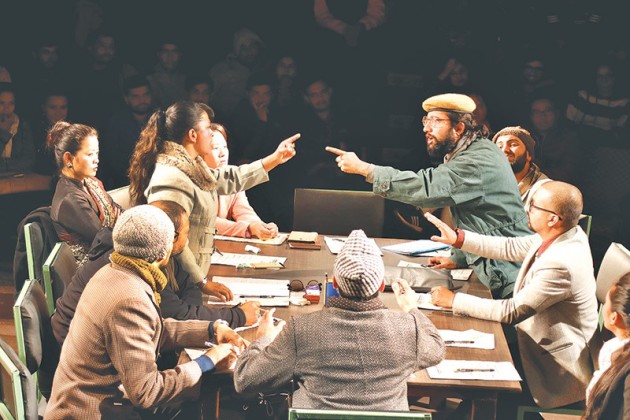Passion and profitability
 Timothy Aryal / April 08: Kathmandu’s theatre scene has seen a renaissance in the last decade. Given the steady rise in the number of audiences—and the number of theatre houses, which has now swelled to four—some would be quick to declare that the art form has now finally come of age. But, despite the progress, how financially viable really is it?
Timothy Aryal / April 08: Kathmandu’s theatre scene has seen a renaissance in the last decade. Given the steady rise in the number of audiences—and the number of theatre houses, which has now swelled to four—some would be quick to declare that the art form has now finally come of age. But, despite the progress, how financially viable really is it?
According to the three directors, representing three different theatre houses in the Capital, theatre remains a profession of passion rather than of profitability. Staging plays, they lament, is still fraught with many risks without the promise of reward.
When audiences go to a play, they immediately become immersed in the setting, the ambiance and the script. But even before a play gets onto a stage there are manifold issues that a theatre house needs to account for. There are scripts to be written or purchased, sets to be designed, costumes to be procured and actors that need to be trained. Yet, who pays for all these initial costs?
“Everytime we put together a play, we are taking on great risks,” admits Rajan Khatiwada, the artistic director of the Anamnagar-based Mandala Theatre, “We, the theatre, end up fronting the entire preliminary budget of the play, which can end up being a huge gamble in the end.”
According to Khatiwada, the average pre-production costs can run anywhere from Rs 100,000 to Rs 200,000. “We allocate Rs 8,000 for daily expenses, if you’d include the rent to be paid out to the landowners,” Khatiwada continues, “Now, with about 22-24 shows per play, and a maximum of 4,000 individual ticket sales in total, it would amount to about Rs 800,000. That would be the ideal situation—but not every play collects that much and, even if it does, it is never enough to adequately support the actors and the stage crew. This is the sad reality.”
According to Khatiwada, the last time a play grossed over average—that is the 2016’s Ra Maailo, which grossed around Rs 800,000 in contrast to the average of Rs 600,000 —each actor was paid Rs 12,000, uniformly, regardless of their roles in the play.
The situation is the same at other theatres. Take for instance, the Kalikasthan-based Sarwanaam Theatre. Sarwanaam’s latest production, Bukhyancha Mann, was a hit, even if the numbers aren’t all too flattering.
The play, according to Raj Shah of Sarwanaam, grossed about four lakhs. “At the very least, we manage to provide lunch and the bus fare to each actor. If only…” he says. Shah, who, besides working at Sarwanaam, supervises film scripts, and also occasionally directs plays for colleges, says, “Theatre only runs on passion and for exposure. It’s a kind of madness.” Shah used the word exposure, to indicate the trend among actors to take theatre as a stepping stone to TV or Kollywood.
Srijana Subba, a leading theatre actor, who has also featured in numerous films, confirms that theatre in Nepal is not for those who want to achieve overnight success. “It’s something run totally because the actors and crew have a strong desire to remain involved. To meet our expenses, we need to engage in initiatives of NGOs or INGOs, which mostly consist of staging plays in far-flung villages. We usually get decent pay from that. And yes, we get paid from regular stagings too, but that is only nominal. There’s nothing like a fixed rate according to the stature and experience of the actors, as there are in movies.”
At Theatre Mall, however, the producers have recently made a provision that at least a sum of Rs 5,000 shall be paid out to actors per play. While Kedar Shrestha, artistic director at Theatre Mall, also works as a drama instructor for children in three schools in town to make ends meet. “Although teaching would not be an ideal job for a theatre artist, what satisfies me is the fact that I have been able to make a living from theatre alone,” Shrestha says.
When artists have to scatter elsewhere for side-jobs, it naturally affects their performance, which might distract their focus and can be reflected in the plays they feature in. But then there are few other options available to them.
“There’s no easy way out,” says Shah. “We often say among ourselves that the total number of audience around the Valley is 7,000, and when there are plays running concurrently, it splits the audience among theatres as well. Given the only source of income for a play is the attendance of the audiences, if we raise the ticket prices, it will only bring down the attendance. So this, for now, is it.”
Rajan Khatiwada, who besides supervising Mandala Theatre also works for the development sector and has appeared occasionally in films, sums things up: “Although the theatre scene has taken a big leap regarding the number of plays produced in the past decade, commercially, it is still struggling. Now, however, the audiences are becoming more and more discerning, and, if you put out a good play, they will watch it. And although the commercialisation of theatre has begun, there’s still a long way to go before it bears any fruit. Until then, you could say, we are just hanging on.” Source: The Kathmandu Post
